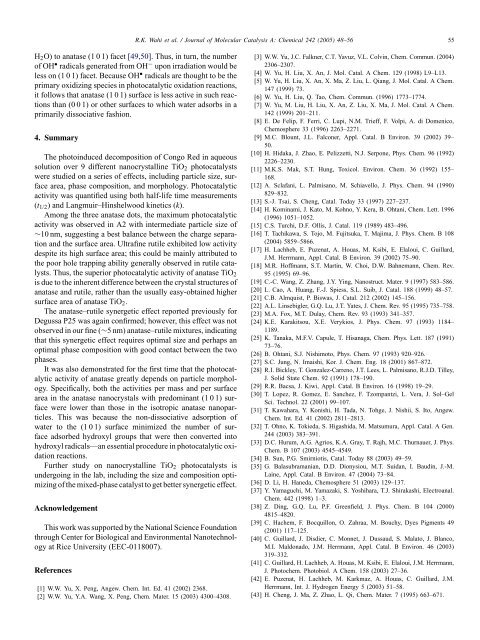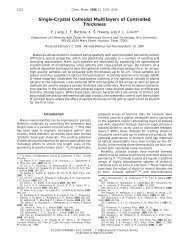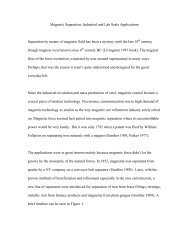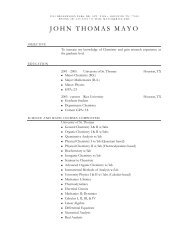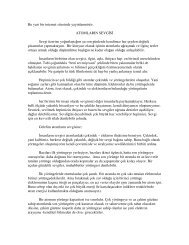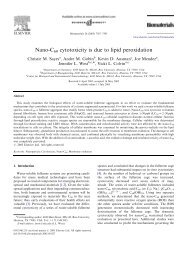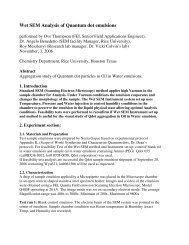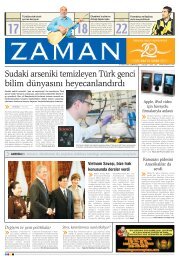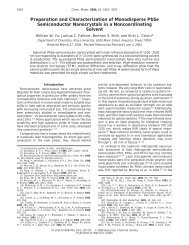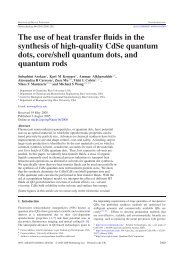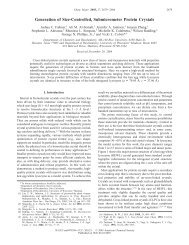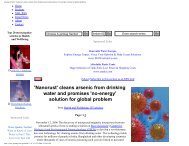Photodegradation of Congo Red catalyzed by nanosized TiO2
Photodegradation of Congo Red catalyzed by nanosized TiO2
Photodegradation of Congo Red catalyzed by nanosized TiO2
Create successful ePaper yourself
Turn your PDF publications into a flip-book with our unique Google optimized e-Paper software.
R.K. Wahi et al. / Journal <strong>of</strong> Molecular Catalysis A: Chemical 242 (2005) 48–56 55<br />
H2O) to anatase (1 0 1) facet [49,50]. Thus, in turn, the number<br />
<strong>of</strong> OH • radicals generated from OH − upon irradiation would be<br />
less on (1 0 1) facet. Because OH • radicals are thought to be the<br />
primary oxidizing species in photocatalytic oxidation reactions,<br />
it follows that anatase (1 0 1) surface is less active in such reactions<br />
than (0 0 1) or other surfaces to which water adsorbs in a<br />
primarily dissociative fashion.<br />
4. Summary<br />
The photoinduced decomposition <strong>of</strong> <strong>Congo</strong> <strong>Red</strong> in aqueous<br />
solution over 9 different nanocrystalline <strong>TiO2</strong> photocatalysts<br />
were studied on a series <strong>of</strong> effects, including particle size, surface<br />
area, phase composition, and morphology. Photocatalytic<br />
activity was quantified using both half-life time measurements<br />
(t1/2) and Langmuir–Hinshelwood kinetics (k).<br />
Among the three anatase dots, the maximum photocatalytic<br />
activity was observed in A2 with intermediate particle size <strong>of</strong><br />
∼10 nm, suggesting a best balance between the charge separation<br />
and the surface area. Ultrafine rutile exhibited low activity<br />
despite its high surface area; this could be mainly attributed to<br />
the poor hole trapping ability generally observed in rutile catalysts.<br />
Thus, the superior photocatalytic activity <strong>of</strong> anatase <strong>TiO2</strong><br />
is due to the inherent difference between the crystal structures <strong>of</strong><br />
anatase and rutile, rather than the usually easy-obtained higher<br />
surface area <strong>of</strong> anatase <strong>TiO2</strong>.<br />
The anatase–rutile synergetic effect reported previously for<br />
Degussa P25 was again confirmed; however, this effect was not<br />
observed in our fine (∼5 nm) anatase–rutile mixtures, indicating<br />
that this synergetic effect requires optimal size and perhaps an<br />
optimal phase composition with good contact between the two<br />
phases.<br />
It was also demonstrated for the first time that the photocatalytic<br />
activity <strong>of</strong> anatase greatly depends on particle morphology.<br />
Specifically, both the activities per mass and per surface<br />
area in the anatase nanocrystals with predominant (1 0 1) surface<br />
were lower than those in the isotropic anatase nanoparticles.<br />
This was because the non-dissociative adsorption <strong>of</strong><br />
water to the (1 0 1) surface minimized the number <strong>of</strong> surface<br />
adsorbed hydroxyl groups that were then converted into<br />
hydroxyl radicals—an essential procedure in photocatalytic oxidation<br />
reactions.<br />
Further study on nanocrystalline <strong>TiO2</strong> photocatalysts is<br />
undergoing in the lab, including the size and composition optimizing<br />
<strong>of</strong> the mixed-phase catalyst to get better synergetic effect.<br />
Acknowledgement<br />
This work was supported <strong>by</strong> the National Science Foundation<br />
through Center for Biological and Environmental Nanotechnology<br />
at Rice University (EEC-0118007).<br />
References<br />
[1] W.W. Yu, X. Peng, Angew. Chem. Int. Ed. 41 (2002) 2368.<br />
[2] W.W. Yu, Y.A. Wang, X. Peng, Chem. Mater. 15 (2003) 4300–4308.<br />
[3] W.W. Yu, J.C. Falkner, C.T. Yavuz, V.L. Colvin, Chem. Commun. (2004)<br />
2306–2307.<br />
[4] W. Yu, H. Liu, X. An, J. Mol. Catal. A Chem. 129 (1998) L9–L13.<br />
[5] W. Yu, H. Liu, X. An, X. Ma, Z. Liu, L. Qiang, J. Mol. Catal. A Chem.<br />
147 (1999) 73.<br />
[6] W. Yu, H. Liu, Q. Tao, Chem. Commun. (1996) 1773–1774.<br />
[7] W. Yu, M. Liu, H. Liu, X. An, Z. Liu, X. Ma, J. Mol. Catal. A Chem.<br />
142 (1999) 201–211.<br />
[8] E. De Felip, F. Ferri, C. Lupi, N.M. Trieff, F. Volpi, A. di Domenico,<br />
Chemosphere 33 (1996) 2263–2271.<br />
[9] M.C. Blount, J.L. Falconer, Appl. Catal. B Environ. 39 (2002) 39–<br />
50.<br />
[10] H. Hidaka, J. Zhao, E. Pelizzetti, N.J. Serpone, Phys. Chem. 96 (1992)<br />
2226–2230.<br />
[11] M.K.S. Mak, S.T. Hung, Toxicol. Environ. Chem. 36 (1992) 155–<br />
168.<br />
[12] A. Sclafani, L. Palmisano, M. Schiavello, J. Phys. Chem. 94 (1990)<br />
829–832.<br />
[13] S.-J. Tsai, S. Cheng, Catal. Today 33 (1997) 227–237.<br />
[14] H. Kominami, J. Kato, M. Kohno, Y. Kera, B. Ohtani, Chem. Lett. 1996<br />
(1996) 1051–1052.<br />
[15] C.S. Turchi, D.F. Ollis, J. Catal. 119 (1989) 483–496.<br />
[16] T. Tachikawa, S. Tojo, M. Fujitsuka, T. Majima, J. Phys. Chem. B 108<br />
(2004) 5859–5866.<br />
[17] H. Lachheb, E. Puzenat, A. Houas, M. Ksibi, E. Elaloui, C. Guillard,<br />
J.M. Herrmann, Appl. Catal. B Environ. 39 (2002) 75–90.<br />
[18] M.R. H<strong>of</strong>fmann, S.T. Martin, W. Choi, D.W. Bahnemann, Chem. Rev.<br />
95 (1995) 69–96.<br />
[19] C.-C. Wang, Z. Zhang, J.Y. Ying, Nanostruct. Mater. 9 (1997) 583–586.<br />
[20] L. Cao, A. Huang, F.-J. Spiess, S.L. Suib, J. Catal. 188 (1999) 48–57.<br />
[21] C.B. Almquist, P. Biswas, J. Catal. 212 (2002) 145–156.<br />
[22] A.L. Linsebigler, G.Q. Lu, J.T. Yates, J. Chem. Rev. 95 (1995) 735–758.<br />
[23] M.A. Fox, M.T. Dulay, Chem. Rev. 93 (1993) 341–357.<br />
[24] K.E. Karakitsou, X.E. Verykios, J. Phys. Chem. 97 (1993) 1184–<br />
1189.<br />
[25] K. Tanaka, M.F.V. Capule, T. Hisanaga, Chem. Phys. Lett. 187 (1991)<br />
73–76.<br />
[26] B. Ohtani, S.J. Nishimoto, Phys. Chem. 97 (1993) 920–926.<br />
[27] S.C. Jung, N. Imaishi, Kor. J. Chem. Eng. 18 (2001) 867–872.<br />
[28] R.I. Bickley, T. Gonzalez-Carreno, J.T. Lees, L. Palmisano, R.J.D. Tilley,<br />
J. Solid State Chem. 92 (1991) 178–190.<br />
[29] R.R. Bacsa, J. Kiwi, Appl. Catal. B Environ. 16 (1998) 19–29.<br />
[30] T. Lopez, R. Gomez, E. Sanchez, F. Tzompantzi, L. Vera, J. Sol–Gel<br />
Sci. Technol. 22 (2001) 99–107.<br />
[31] T. Kawahara, Y. Konishi, H. Tada, N. Tohge, J. Nishii, S. Ito, Angew.<br />
Chem. Int. Ed. 41 (2002) 2811–2813.<br />
[32] T. Ohno, K. Tokieda, S. Higashida, M. Matsumura, Appl. Catal. A Gen.<br />
244 (2003) 383–391.<br />
[33] D.C. Hurum, A.G. Agrios, K.A. Gray, T. Rajh, M.C. Thurnauer, J. Phys.<br />
Chem. B 107 (2003) 4545–4549.<br />
[34] B. Sun, P.G. Smirniotis, Catal. Today 88 (2003) 49–59.<br />
[35] G. Balasubramanian, D.D. Dionysiou, M.T. Suidan, I. Baudin, J.-M.<br />
Laine, Appl. Catal. B Environ. 47 (2004) 73–84.<br />
[36] D. Li, H. Haneda, Chemosphere 51 (2003) 129–137.<br />
[37] Y. Yamaguchi, M. Yamazaki, S. Yoshihara, T.J. Shirakashi, Electroanal.<br />
Chem. 442 (1998) 1–3.<br />
[38] Z. Ding, G.Q. Lu, P.F. Greenfield, J. Phys. Chem. B 104 (2000)<br />
4815–4820.<br />
[39] C. Hachem, F. Bocquillon, O. Zahraa, M. Bouchy, Dyes Pigments 49<br />
(2001) 117–125.<br />
[40] C. Guillard, J. Disdier, C. Monnet, J. Dussaud, S. Malato, J. Blanco,<br />
M.I. Maldonado, J.M. Herrmann, Appl. Catal. B Environ. 46 (2003)<br />
319–332.<br />
[41] C. Guillard, H. Lachheb, A. Houas, M. Ksibi, E. Elaloui, J.M. Herrmann,<br />
J. Photochem. Photobiol. A Chem. 158 (2003) 27–36.<br />
[42] E. Puzenat, H. Lachheb, M. Karkmaz, A. Houas, C. Guillard, J.M.<br />
Herrmann, Int. J. Hydrogen Energy 5 (2003) 51–58.<br />
[43] H. Cheng, J. Ma, Z. Zhao, L. Qi, Chem. Mater. 7 (1995) 663–671.


